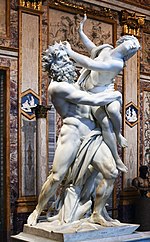Galleria Borghese

The Galleria Borghese (Italian for 'Borghese Gallery') is an art gallery in Rome, Italy, housed in the former Villa Borghese Pinciana. At the outset, the gallery building was integrated with its gardens, but nowadays the Villa Borghese gardens are considered a separate tourist attraction. The Galleria Borghese houses a substantial part of the Borghese Collection of paintings, sculpture and antiquities, begun by Cardinal Scipione Borghese, the nephew of Pope Paul V (reign 1605–1621). The building was constructed by the architect Flaminio Ponzio, developing sketches by Scipione Borghese himself, who used it as a villa suburbana, a country villa at the edge of Rome. Scipione Borghese was an early patron of Bernini and an avid collector of works by Caravaggio, who is well represented in the collection by his Boy with a Basket of Fruit, St Jerome Writing, Sick Bacchus and others. Additional paintings of note include Titian's Sacred and Profane Love, Raphael's Entombment of Christ and works by Peter Paul Rubens and Federico Barocci.
Excerpt from the Wikipedia article Galleria Borghese (License: CC BY-SA 3.0, Authors, Images).Galleria Borghese
Piazzale del Museo Borghese, Rome Pinciano
Geographical coordinates (GPS) Address Nearby Places Show on map
Geographical coordinates (GPS)
| Latitude | Longitude |
|---|---|
| N 41.914166666667 ° | E 12.491944444444 ° |
Address
Casino Nobile di Villa Borghese
Piazzale del Museo Borghese 5
00197 Rome, Pinciano
Lazio, Italy
Open on Google Maps










